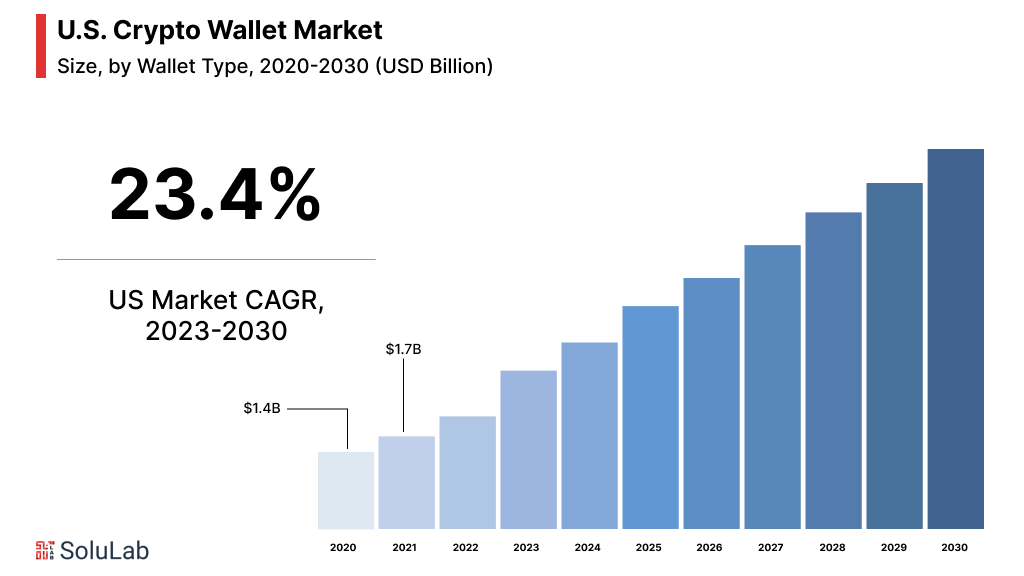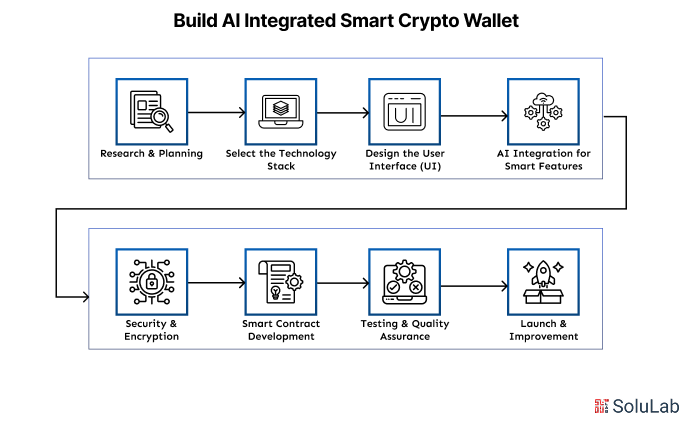Have you ever thought about a cryptocurrency wallet that offers features beyond the storage of your digital assets? The rise of AI crypto wallets has made this possible. These wallets have been designed to help users make informed choices, identify suspicious activities, and provide valuable recommendations based on their app usage.
As more people get into cryptocurrency, the tools they use must become smarter and more user-friendly. AI contributes by providing features such as automated suggestions, smart notifications, and voice control. It’s similar to having a helpful assistant built into your wallet, directing you along the way.
In this article, we will look at how to build your own AI-enabled crypto wallets. Whether you’re a developer or simply interested, we’ll make things easy and walk you through the stages, tools, and suggestions to get started!
The Journey of Crypto Wallets
Back when Bitcoin first came around in 2009, crypto wallets were pretty basic software that helped you store your private keys and maybe send or receive a few coins. Just enough to interact with the blockchain and keep your assets safe. But as more people started getting into crypto, wallets had to level up. Developers began building wallets that could handle multiple tokens and feel easier to use.
TRC20 wallets were then upgraded with the TRON blockchain, and some of them have started using AI to make transactions smoother and boost security. These wallets are learning, adjusting, and reacting in real time. It’s the start of the AI-integrated smart crypto wallets era. Security has also become a bigger deal lately. Features like multi-signature approvals and HD wallets started showing up. These additions give users a lot more control.
Now, wallets aren’t just storage tools anymore. They are evolving into full-blown financial dashboards. Some can track spending habits, spot suspicious activity, and even automate routine tasks. And they’re doing all this while keeping your crypto safe in the background. Not bad for something that started as a simple keyholder.
Market Statistics for Smart Crypto Wallets in 2025
The AI-integrated smart cryptocurrency wallet industry is predicted to develop rapidly through 2025 and beyond. This is due to the growing acceptance of blockchain technology across businesses, as well as increased demand for safe cryptocurrency transactions and developments in AI integration for improved functionality and security.
Key Statistics and Trends:
- According to a Grand View Research report, the worldwide AI crypto wallet industry is anticipated to be worth USD 8.42 billion in 2022, with a compound annual growth rate (CAGR) of 24.8% from 2023 to 2030.
- In 2023, the worldwide smart wallet market was estimated to be worth USD 289.16 million. Additionally, it is expected to reach USD 519.22 million by 2032. It will grow at a CAGR of 6.72% from 2024 to 2032. As a result, market expansion is ascribed to digital transformation and increased e-commerce growth.

Key Features of a Next-Level Smart Crypto Wallet
Today’s smart wallets aren’t just about storing coins anymore. They’ve got to be secure, easy to use, and flexible enough to keep up with how people actually use crypto. If you’re thinking of building one, here’s what needs to be on your checklist.
1. Handles Different Coins in One Place
A good wallet should support a bunch of cryptocurrencies, not just Bitcoin or Ethereum. You want to be able to manage everything—from top-tier coins to up-and-coming tokens—without juggling multiple apps. That’s what makes an AI-integrated smart crypto wallet feel truly “smart.”
2. Works Across Devices
People don’t stick to one device anymore. Your wallet should work on a phone, laptop, or tablet, and sync across all of them. Whether you’re on Android at work or checking from a Mac at home, your info should be up to date no matter where you log in.
3. Security That Doesn’t Get in the Way
Strong security is non-negotiable. Things like biometric logins, 2FA, and solid encryption need to be built in. But they shouldn’t make the app feel clunky or slow. Ideally, security should feel invisible, working in the background while keeping your assets safe.
4. Stores Keys With the User
A proper wallet doesn’t store your private keys on some central server. It keeps them on your own device. That way, you control your funds, and if something goes wrong with a central system, you’re not at risk.
5. Multi-Sig for Shared Access
If the wallet is being used by a group—say, a team or DAO—it should allow multiple approvals for transactions. That’s where multi-signature support comes in handy. It adds a layer of trust and reduces the risk of unauthorized transfers.
6. Built-In Swap Feature
Being able to exchange tokens without leaving the wallet? That’s a big win. It saves time, reduces fees, and just feels seamless. This is one of the features that separates a good user experience from a frustrating one.
7. QR Code Transfers
Ever tried typing a wallet address? It’s a nightmare. QR codes simplify this. Scan to send, scan to receive—it should be that easy. Especially useful in retail or face-to-face payments.

Why Integrating AI Can Transform Your Crypto Wallet?
Ever found yourself wondering whether it’s really worth building your own AI-based crypto wallet when there are already so many options on the app stores? Here’s a look at why developing one yourself can actually make a big difference—and offer some real advantages.
-
More Control Over Security
When you build your own crypto wallet, you’re not stuck depending on someone else’s framework or hoping a third-party backend is secure. You’re in full control. That gives you the flexibility to design your own security protocols, tailored to your exact needs. What’s more, integrating AI agents for finance into the system adds a powerful layer of protection. These agents can keep an eye on real-time activity, spot red flags early, and help prevent issues before they turn into serious problems.
-
Personalized Features and Automation
One of the biggest plus points of AI is how it can tailor the wallet to your personal needs. Whether it’s letting the system handle transaction approvals or helping manage your crypto portfolio more smoothly, AI makes everyday tasks simpler. It can even help with automatically running smart contracts based on predefined triggers.
-
Helping You Make Better Calls
An AI-supported wallet doesn’t just sit there—it learns. It can pull live data from the market, check past transactions, and even spot trends. So, if you’re unsure when to buy or sell, it can offer suggestions based on what’s actually happening, not just guesswork.
-
A Chance to Learn While You Build
Starting from scratch with an AI-driven crypto wallet isn’t just about having something custom. It’s a hands-on opportunity to understand how blockchain systems work, explore AI applications, and get familiar with security practices that actually hold up. It’s a smart way to learn how these technologies connect in the real world.
When it comes to the role of AI in crypto wallets, it’s not just about features—it’s about building smarter, more responsive tools that adapt to how people actually use crypto. And if you’re building it yourself, that wallet works exactly the way you need it to.
Step-by-Step Breakdown to Build Your Own AI-Powered Crypto Wallet

Building a crypto wallet that smartly blends AI capabilities with blockchain features takes more than just coding—it’s a thoughtful process. From laying out the concept to rolling out the final product, here’s a walkthrough of how to create a wallet that’s secure, intelligent, and user-first.
1. Research and Planning
Before you begin development, it’s essential to dive deep into research. Take time to understand the current crypto wallet market—what’s working, what’s not, and where users struggle. Then look at where AI can offer real value. Think beyond buzzwords—maybe smarter alerts, stronger fraud protection, or auto-generated suggestions for trading timing.
2. Select the Technology Stack
The tools you choose will shape how well your wallet performs and scales. For the blockchain layer, many developers go with platforms like Ethereum, Solana, or Binance Smart Chain. On the AI side, it makes sense to explore frameworks like PyTorch or TensorFlow—each offers solid support for training and integrating models. The blend depends on what your wallet is meant to do.
3. Design the User Interface
For any app to gain traction, design matters. And in crypto, that’s even more true. Focus on a layout that feels simple, even to someone who isn’t deeply technical. Users should be able to check their balances, send tokens, and get insights powered by AI without having to dig through menus or manuals. A well-thought-out UI can make or break adoption.
4. AI Integration for Smart Features
Artificial intelligence can do a lot—but only if it’s used wisely. A crypto wallet can offer things like customized financial advice, automatic portfolio adjustments, or even warnings about shady-looking activity. Machine learning models can track user behavior and market trends to offer meaningful, real-time suggestions, not just surface-level alerts.
5. Security and Encryption
With crypto, safety isn’t optional—it’s a must. That means using encryption standards to protect private keys and sensitive data, and including two-factor logins to verify identities. AI plays a part here, too—it can analyze user behavior to spot anomalies or flag risky access attempts before any damage is done.
6. Smart Contract Development
A wallet that supports decentralized finance needs to connect with smart contracts. These aren’t just about transactions—they can handle staking, swaps, or lending protocols directly from the wallet. With the help of top AI cryptocurrency wallet development, you can bake in automation that moves assets based on triggers without requiring manual input or outside middlemen.
7. Testing and Quality Assurance
You don’t want bugs in production, especially when money’s involved. Thorough testing, including both feature checks and security validation, is a must. Stress testing for high-traffic use, edge cases, and verifying that your AI modules behave accurately should all be part of the process before go-live.
8. Launch and Improvement
Once you’re confident everything works, it’s time to launch—whether through mobile stores or web platforms. But it doesn’t stop there. Gather feedback, observe how users interact with the wallet, and make improvements. Regular updates can introduce fresh AI features, better UX, and stronger security protocols over time.
What Does It Cost to Build an AI-Powered Crypto Wallet?
If you’re thinking about building an AI-integrated smart crypto wallet, you’re probably asking the big question: what’s the cost? Well, there’s no fixed number. The total budget can vary a lot depending on the scope of the project, what features you want, and even where your development team is based.
Different regions charge differently, and of course, more complex features (like real-time AI analytics or DeFi integration) will push the cost higher. For anyone planning to enter this space—or even wants to start a cryptocurrency exchange with a custom wallet solution—it helps to have a rough idea of what goes into the budget.
Below is a general estimate of what each stage in the crypto wallet development process might cost you:
| Development Phase | Estimated Cost (USD) |
| Market & User Research | $5,000 – $15,000 |
| Interface & Experience Design | $10,000 – $30,000 |
| Backend Architecture | $20,000 – $50,000 |
| AI Feature Integration | $15,000 – $40,000 |
| Security Layers & Encryption | $10,000 – $25,000 |
| QA & Final Testing | $5,000 – $15,000 |
| Product Launch & Promotion | $10,000 – $30,000 |
Popular AI-Integrated Crypto Wallets You Should Know About
Over the past couple of years, a few crypto wallets have quietly stepped up their game by blending AI into their core functionality, not as a gimmick, but as a real value add for users. These wallets don’t just hold tokens; they help manage them smarter, track patterns, flag risks, and sometimes even suggest the best time to move assets. If you’re curious about what’s out there already, here are a few worth mentioning.
1. Frontier Wallet
Frontier is known for supporting a wide range of DeFi protocols and asset-backed cryptocurrencies, but it’s also been making strides by adding AI-driven tools to simplify investment tracking. While its AI features aren’t always front and center, they assist with things like transaction categorization and identifying potential risks in DeFi positions, especially useful for users juggling multiple protocols.
2. ELLIPAL Titan
This one’s a hardware wallet, but it’s paired with a smart app that uses AI for transaction monitoring and anomaly detection. The AI component flags anything that looks out of the ordinary, giving users a heads-up before something potentially harmful happens. It’s a solid pick for those who want both cold storage and active AI support.
3. YouHodler
YouHodler blends lending, trading, and wallet functions all in one place. The wallet part benefits from machine learning models that offer real-time price analysis and smart alerts based on user behavior. It’s more than a passive wallet—it helps users make choices with better timing and data.
4. Klever Wallet
While Klever started as a simple mobile wallet, newer versions have begun using AI in subtle ways, like optimizing gas fees, flagging abnormal sending behavior, and offering suggestions based on previous transaction patterns. It’s a good example of how AI doesn’t have to be flashy to be useful.
These wallets show that the shift toward smarter, data-aware crypto tools is already happening. For businesses or developers exploring crypto wallet development, looking at how these platforms quietly integrate AI can offer some real inspiration. The goal isn’t to overcomplicate things—it’s to make crypto safer, easier, and a little more intuitive for everyday users.
The Future of Crypto Wallets and AI
The way people use crypto wallets is changing fast. What started as simple tools to store private keys is now evolving into full-service financial platforms. As user expectations grow, wallets are being built to do more—track spending, simplify cross-chain transfers, and even guide users on the best time to make a move. The future? It’s not just about holding crypto; it’s about managing digital wealth in smarter, safer ways.
This is where AI trends are starting to shape what’s possible. We’re already seeing wallets that adapt to user habits, flag irregular activity, and even offer smart recommendations based on real-time market shifts. As these technologies continue to mature, AI won’t just be a nice-to-have—it’ll be at the core of how next-gen wallets operate, bringing everyday users closer to a more intuitive and secure crypto experience.

The Bottom Line
As the world of digital finance grows more complex, the role of smart crypto wallets continues to expand. We’re moving beyond basic storage into a new era where AI and blockchain work hand in hand, bringing better insights, stronger security, and more control to everyday users.
At SoluLab, a leading cryptocurrency development company, we’ve been helping companies navigate this space with end-to-end blockchain solutions. We recently worked for a platform focused on advanced digital marketing and web traffic analytics. We developed a native crypto wallet tailored to their ecosystem, enabling secure asset management alongside unique features like call tracking and multi-source traffic monitoring. With this wallet integrated into their blockchain-powered platform, Clicktool users can now track ROI, manage campaigns, and analyze markets with more precision than ever before.
If you’re exploring new ways to bring AI and blockchain into your next wallet or digital platform, now is the time. Whether you’re just getting started or looking to upgrade an existing product, our team’s here to guide you every step of the way. Contact Now!
FAQs
1. Why build own AI-integrated crypto wallet instead of using an existing one?
Building your own wallet gives you full control over its features, security standards, and data management. Unlike third-party apps, where you’re relying on someone else’s code, your own wallet lets you decide exactly how it works—plus you can tailor the AI features to your users’ specific needs, from smarter analytics to fraud detection.
2. What are some real benefits of using AI in a crypto wallet?
AI helps a wallet do more than just store and send crypto. It can offer smart alerts, track unusual activity, give market insights, and even help automate decisions like when to buy, sell, or hold. It turns the wallet into more of an assistant than a simple storage tool.
3. How does AI improve security in a crypto wallet?
AI can monitor transaction patterns and detect behaviors that seem out of the ordinary. If something unusual is going on—like a login from a new device or an unusual withdrawal—it can send alerts or even trigger preventive measures before things go south.
4. Is AI only for large-scale or enterprise-level wallets?
Not at all. While big companies may invest more in advanced AI tools, smaller projects and startups can still benefit. Even basic AI features like predictive analytics or anomaly detection can improve user experience and add value without needing a massive budget.
5. Are AI wallets safe to use if someone is not very tech-savvy?
Yes, most modern AI wallets are built with user experience in mind. You don’t need to be a developer or trader to use them. In fact, the AI does much of the heavy lifting in the background, so you can focus on managing your assets with confidence.





.jpg?w=380&resize=380,220&ssl=1)
